Management Accounting Assignment: Cost Analysis and Reporting
VerifiedAdded on 2019/12/03
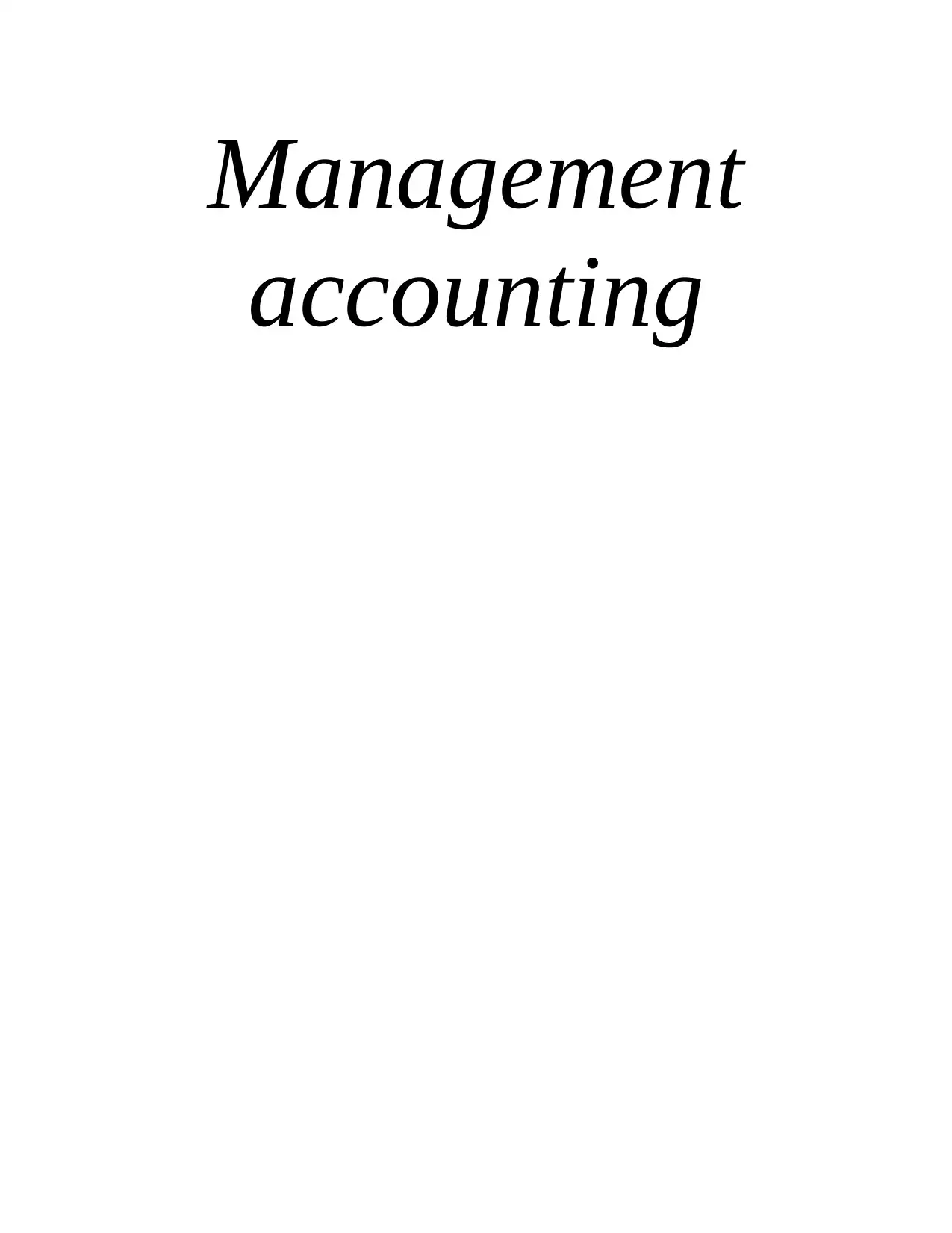
accounting
Paraphrase This Document
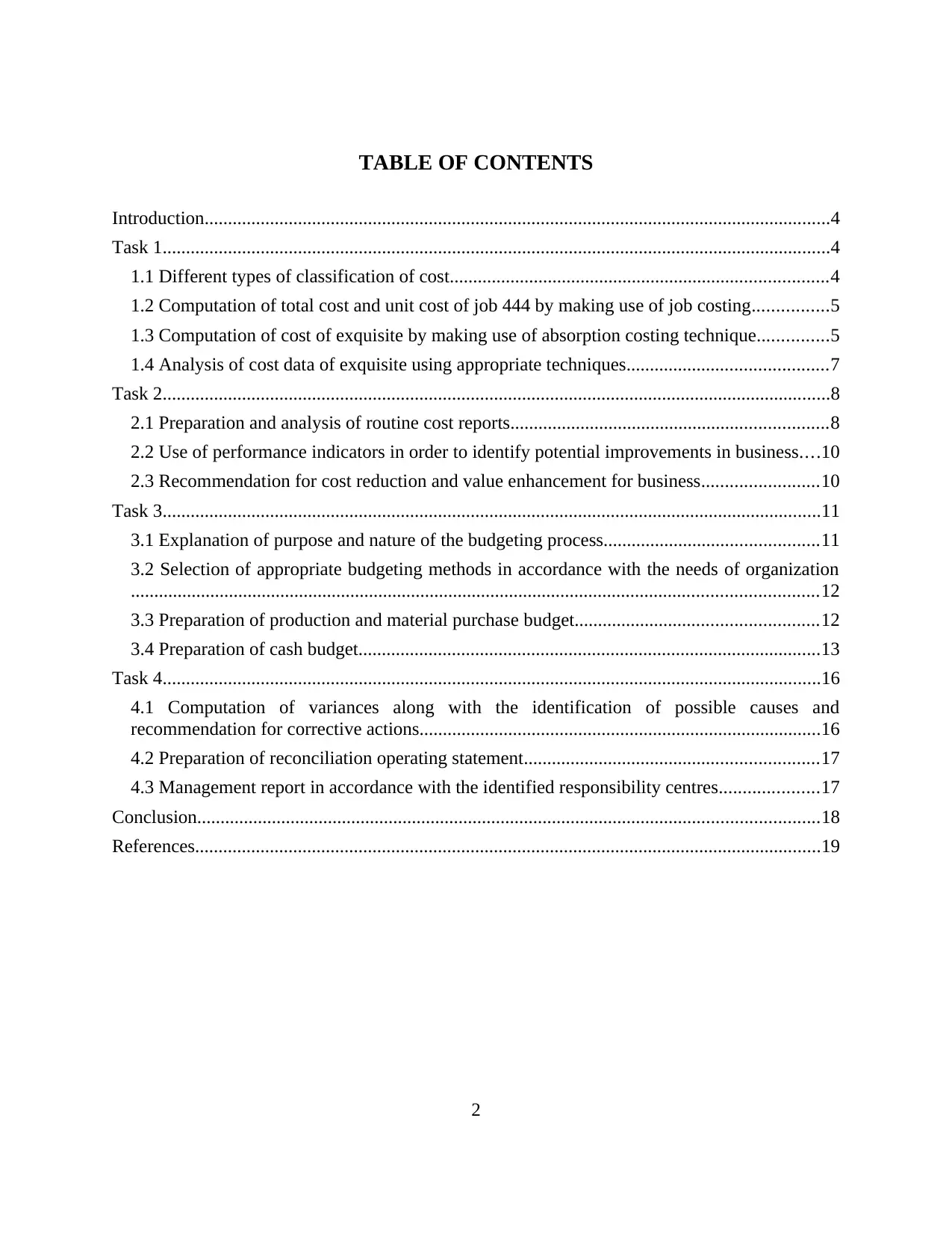
Introduction......................................................................................................................................4
Task 1...............................................................................................................................................4
1.1 Different types of classification of cost.................................................................................4
1.2 Computation of total cost and unit cost of job 444 by making use of job costing................5
1.3 Computation of cost of exquisite by making use of absorption costing technique...............5
1.4 Analysis of cost data of exquisite using appropriate techniques...........................................7
Task 2...............................................................................................................................................8
2.1 Preparation and analysis of routine cost reports....................................................................8
2.2 Use of performance indicators in order to identify potential improvements in business....10
2.3 Recommendation for cost reduction and value enhancement for business.........................10
Task 3.............................................................................................................................................11
3.1 Explanation of purpose and nature of the budgeting process..............................................11
3.2 Selection of appropriate budgeting methods in accordance with the needs of organization
...................................................................................................................................................12
3.3 Preparation of production and material purchase budget....................................................12
3.4 Preparation of cash budget...................................................................................................13
Task 4.............................................................................................................................................16
4.1 Computation of variances along with the identification of possible causes and
recommendation for corrective actions......................................................................................16
4.2 Preparation of reconciliation operating statement...............................................................17
4.3 Management report in accordance with the identified responsibility centres.....................17
Conclusion.....................................................................................................................................18
References......................................................................................................................................19
2
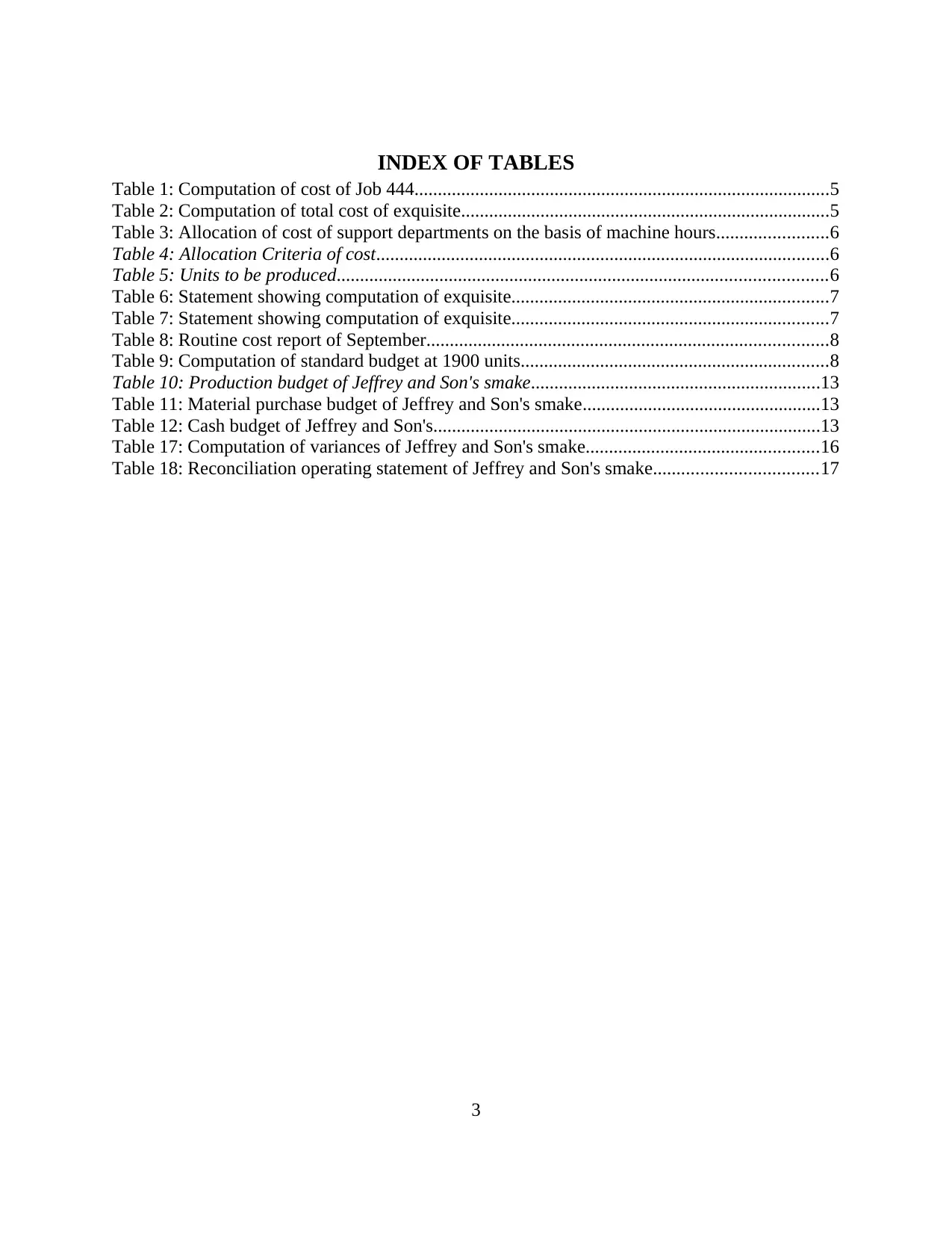
Table 1: Computation of cost of Job 444.........................................................................................5
Table 2: Computation of total cost of exquisite...............................................................................5
Table 3: Allocation of cost of support departments on the basis of machine hours........................6
Table 4: Allocation Criteria of cost.................................................................................................6
Table 5: Units to be produced.........................................................................................................6
Table 6: Statement showing computation of exquisite....................................................................7
Table 7: Statement showing computation of exquisite....................................................................7
Table 8: Routine cost report of September......................................................................................8
Table 9: Computation of standard budget at 1900 units..................................................................8
Table 10: Production budget of Jeffrey and Son's smake..............................................................13
Table 11: Material purchase budget of Jeffrey and Son's smake...................................................13
Table 12: Cash budget of Jeffrey and Son's...................................................................................13
Table 17: Computation of variances of Jeffrey and Son's smake..................................................16
Table 18: Reconciliation operating statement of Jeffrey and Son's smake...................................17
3
⊘ This is a preview!⊘
Do you want full access?
Subscribe today to unlock all pages.

Trusted by 1+ million students worldwide
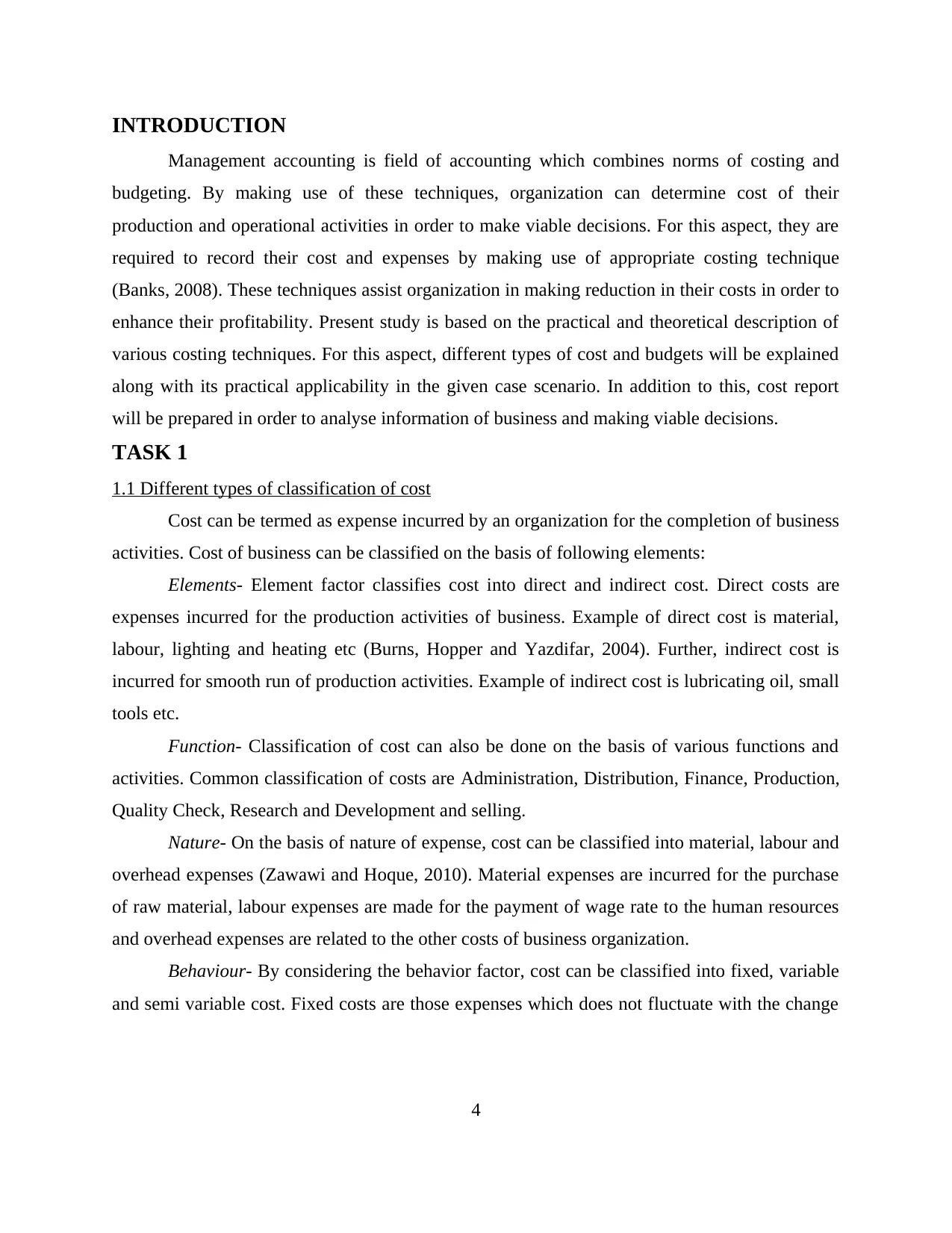
Management accounting is field of accounting which combines norms of costing and
budgeting. By making use of these techniques, organization can determine cost of their
production and operational activities in order to make viable decisions. For this aspect, they are
required to record their cost and expenses by making use of appropriate costing technique
(Banks, 2008). These techniques assist organization in making reduction in their costs in order to
enhance their profitability. Present study is based on the practical and theoretical description of
various costing techniques. For this aspect, different types of cost and budgets will be explained
along with its practical applicability in the given case scenario. In addition to this, cost report
will be prepared in order to analyse information of business and making viable decisions.
TASK 1
1.1 Different types of classification of cost
Cost can be termed as expense incurred by an organization for the completion of business
activities. Cost of business can be classified on the basis of following elements:
Elements- Element factor classifies cost into direct and indirect cost. Direct costs are
expenses incurred for the production activities of business. Example of direct cost is material,
labour, lighting and heating etc (Burns, Hopper and Yazdifar, 2004). Further, indirect cost is
incurred for smooth run of production activities. Example of indirect cost is lubricating oil, small
tools etc.
Function- Classification of cost can also be done on the basis of various functions and
activities. Common classification of costs are Administration, Distribution, Finance, Production,
Quality Check, Research and Development and selling.
Nature- On the basis of nature of expense, cost can be classified into material, labour and
overhead expenses (Zawawi and Hoque, 2010). Material expenses are incurred for the purchase
of raw material, labour expenses are made for the payment of wage rate to the human resources
and overhead expenses are related to the other costs of business organization.
Behaviour- By considering the behavior factor, cost can be classified into fixed, variable
and semi variable cost. Fixed costs are those expenses which does not fluctuate with the change
4
Paraphrase This Document
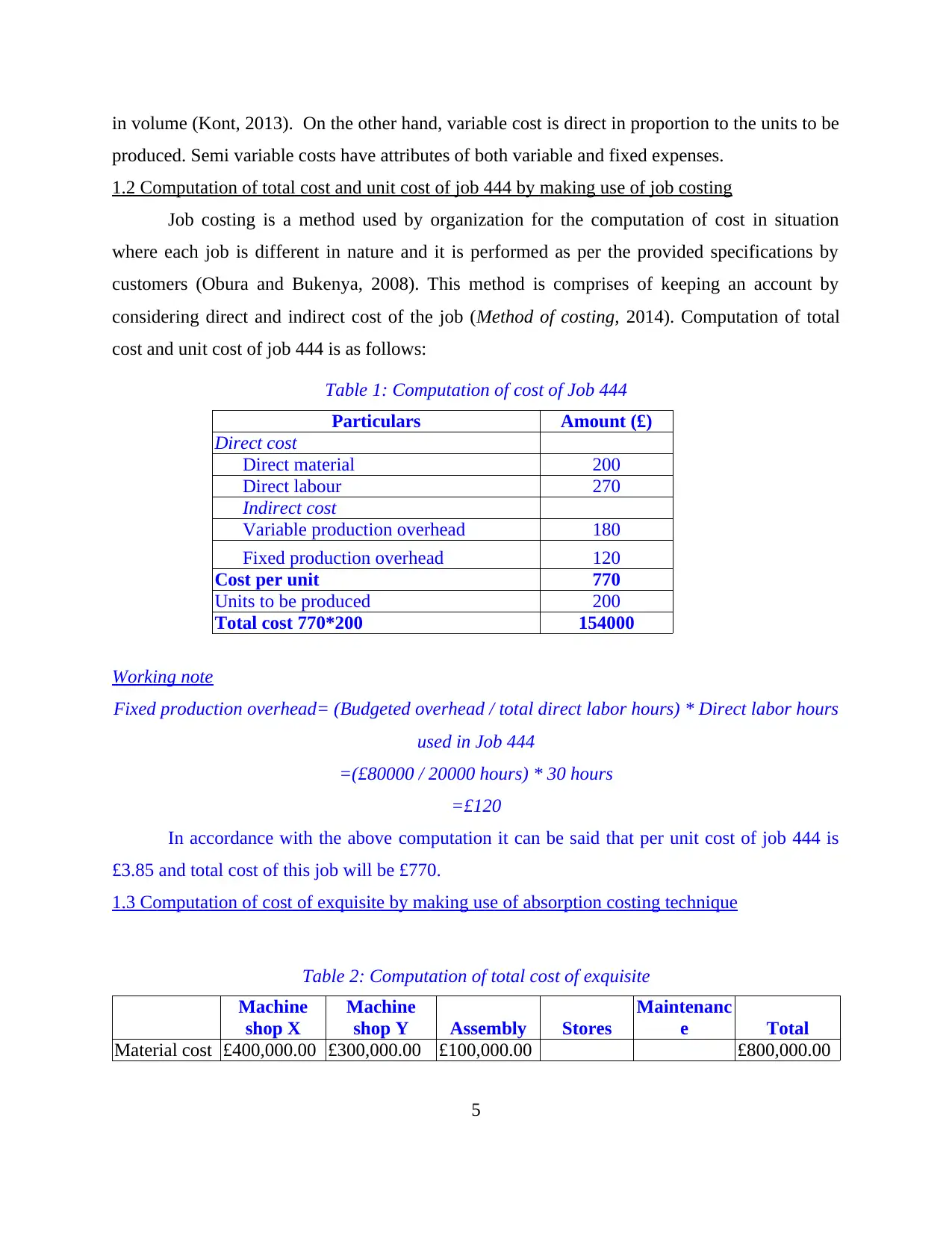
produced. Semi variable costs have attributes of both variable and fixed expenses.
1.2 Computation of total cost and unit cost of job 444 by making use of job costing
Job costing is a method used by organization for the computation of cost in situation
where each job is different in nature and it is performed as per the provided specifications by
customers (Obura and Bukenya, 2008). This method is comprises of keeping an account by
considering direct and indirect cost of the job (Method of costing, 2014). Computation of total
cost and unit cost of job 444 is as follows:
Table 1: Computation of cost of Job 444
Particulars Amount (£)
Direct cost
Direct material 200
Direct labour 270
Indirect cost
Variable production overhead 180
Fixed production overhead 120
Cost per unit 770
Units to be produced 200
Total cost 770*200 154000
Working note
Fixed production overhead= (Budgeted overhead / total direct labor hours) * Direct labor hours
used in Job 444
=(£80000 / 20000 hours) * 30 hours
=£120
In accordance with the above computation it can be said that per unit cost of job 444 is
£3.85 and total cost of this job will be £770.
1.3 Computation of cost of exquisite by making use of absorption costing technique
Table 2: Computation of total cost of exquisite
Machine
shop X
Machine
shop Y Assembly Stores
Maintenanc
e Total
Material cost £400,000.00 £300,000.00 £100,000.00 £800,000.00
5

Indirect
wages and
supervision £100,000.00 £99,500.00 £92,500.00 £10,000.00 £60,000.00 £362,000.00
Indirect
materials £100,000.00 £100,000.00 £40,000.00 £4,000.00 £9,000.00 £253,000.00
Light and
heating £10,000.00 £5,000.00 £15,000.00 £15,000.00 £5,000.00 £50,000.00
Rent £20,000.00 £10,000.00 £30,000.00 £30,000.00 £10,000.00 £100,000.00
Insurance
and
machinery £7,947.02 £4,966.89 £993.38 £496.69 £596.03 £15,000.00
Depreciation
of machinery £79,470.20 £49,668.87 £9,933.77 £4,966.89 £5,960.26 £150,000.00
Insurance of
building £5,000.00 £2,500.00 £7,500.00 £7,500.00 £2,500.00 £25,000.00
Salaries of
works
management £24,000.00 £16,000.00 £24,000.00 £8,000.00 £8,000.00 £80,000.00
Total cost of
overhead £346,147.00 £287,636.00 £219,927.00 £79,964.00 £101,056.00
Table 3: Allocation of cost of support departments on the basis of machine hours
Machine shop X Machine shop Y Assembly Total
Store £39,982.00 £29,987.00 £9,995.00 £79,964.00
Maintenance £45,807.00 £32,338.00 £20,211.75 £101,056.00
Total £434,906.00 £349,961.00 £250,133.00
Table 4: Allocation Criteria of cost
Particulars Description
Indirect wages and supervision As per the provided amount.
Indirect materials As per the provided amount.
Light and heating On the basis of area occupied
Rent On the basis of area occupied
Insurance and machinery On the basis of book value of machine
Depreciation of machinery On the basis of book value of machine
Insurance of building On the basis of area occupied
Salaries of works management On the basis of number of employees.
Table 5: Units to be produced
Material cost £400,000.00 £300,000.00 £100,000.00
6
⊘ This is a preview!⊘
Do you want full access?
Subscribe today to unlock all pages.

Trusted by 1+ million students worldwide

A/B no. of units 50000 37500 12500
Overhead absorption rate
Machinery X= 434906/80000=5.44
Machinery Y= 349960/60000= 5.83
Assembly=250134/10000=25.01
Computation of absorption rate
Table 6: Statement showing computation of exquisite
£ £
Materials 8
Labour 15
Overheads
X (0.8*5.44) 4.34
Y (.6*5.83) 3.5
Assembly (.1*25.01) 2.5
Total cost 33.35
1.4 Analysis of cost data of exquisite using appropriate techniques
Overhead absorption rate on the basis of labour hours
Machinery X= 434908/200000= 2.17
Machinery Y= 349960/150000= 2.33
Assembly=250134/20000= 2.15
Table 7: Statement showing computation of exquisite
£ £
Materials 8
7
Paraphrase This Document
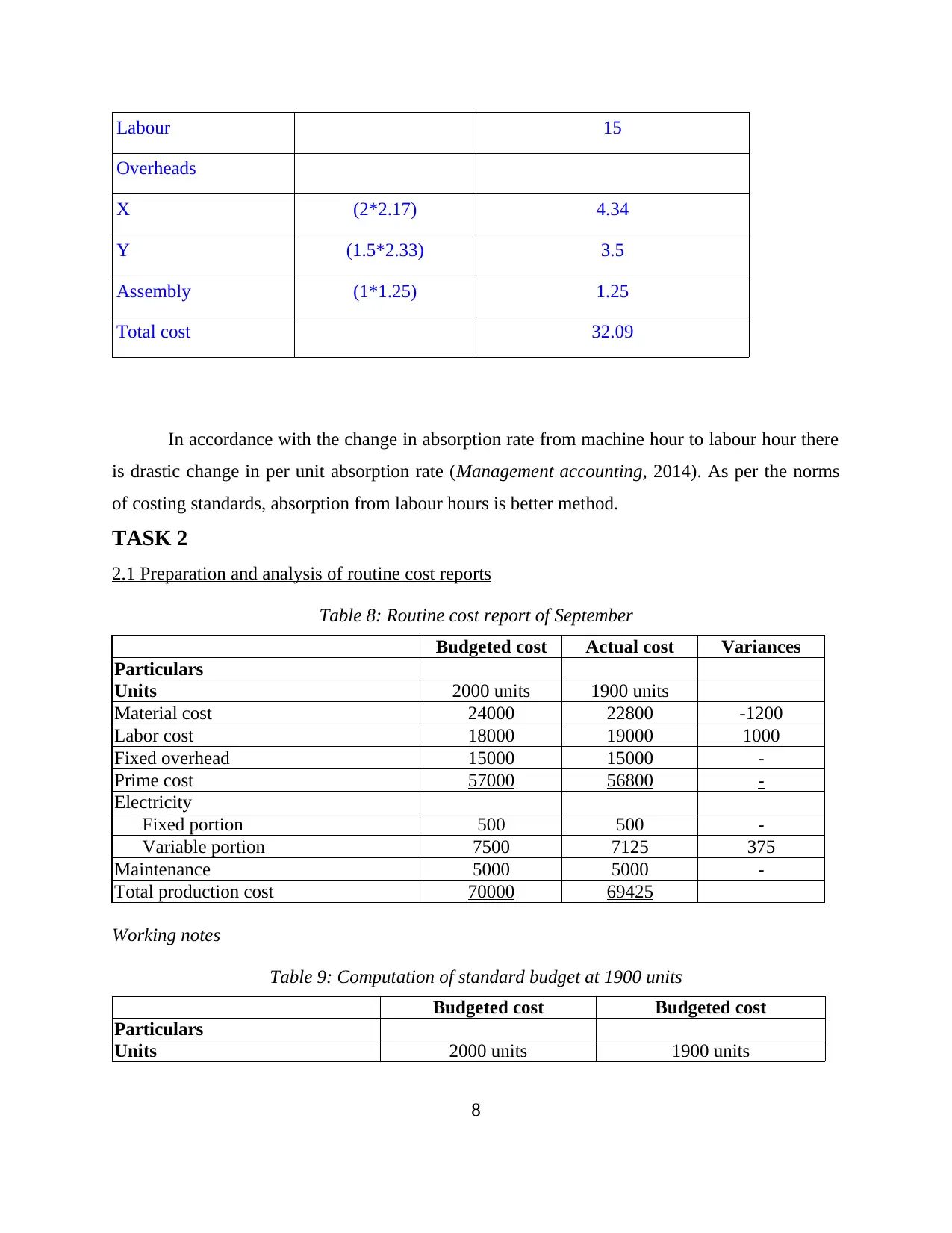
Overheads
X (2*2.17) 4.34
Y (1.5*2.33) 3.5
Assembly (1*1.25) 1.25
Total cost 32.09
In accordance with the change in absorption rate from machine hour to labour hour there
is drastic change in per unit absorption rate (Management accounting, 2014). As per the norms
of costing standards, absorption from labour hours is better method.
TASK 2
2.1 Preparation and analysis of routine cost reports
Table 8: Routine cost report of September
Budgeted cost Actual cost Variances
Particulars
Units 2000 units 1900 units
Material cost 24000 22800 -1200
Labor cost 18000 19000 1000
Fixed overhead 15000 15000 -
Prime cost 57000 56800 -
Electricity
Fixed portion 500 500 -
Variable portion 7500 7125 375
Maintenance 5000 5000 -
Total production cost 70000 69425
Working notes
Table 9: Computation of standard budget at 1900 units
Budgeted cost Budgeted cost
Particulars
Units 2000 units 1900 units
8

Labor cost 18000 17100
Fixed overhead 15000 15000
Prime cost 57000 54900
Electricity
Fixed portion 500 500
Variable portion 7500 7125
Maintenance 5000 5000
Total production cost 70000 67525
Computation of variable cost - Electricity
=Change in total cost / Change in no. of units to be produced
=(8000-5000)/(2000-1200)
=£3.75
Computation of stepped cost
Maintenance cost will not be altered, because it is occurred on the slot of 500. By
considering this aspect, reduction of 100 units will not make any difference in the cost.
Comment on variance
Material cost- There is favourable variance in amount of material because there is no
change in per unit cost and nature of material is variable. Due to this aspect, it is proportionate to
the units to be produced (Chapman, 2008). Due to this aspect, reduction in production unit will
also decrease the cost of material.
Labour cost- There is adverse variance in labour cost of 1000. However actual variance is
of 1900. It is because, estimated labour cost per unit is of 9 and actual labour cost is 10. Due to
this aspect, on each unit organization is required to pay additional amount of 1 (Bhimani and
Bromwich, 2009). Amount of 900 is compensated in the variance because budgeted computation
of 20000 units is done on 9 and actual computation of 18000 units is done on 10.
Fixed overhead- There is no variance in amount of fixed overhead. It is because; it is fixed in
nature. With the increase or decrease in units of production there will be no change in amount of
fixed expense.
Electricity- Nature of electricity expense is semi variable in nature. Thus, this amount has
component of both fixed and variable expense. In accordance with the above computation it can
9
⊘ This is a preview!⊘
Do you want full access?
Subscribe today to unlock all pages.

Trusted by 1+ million students worldwide

portion is decreased proportionately.
Maintenance- Maintenance charges are stepped cost. It increased with the increase in slot
of 500. By considering this aspect, there will not be any change in amount of maintenance cost.
It is because; reduction of 100 units will not make any difference in the cost.
2.2 Use of performance indicators in order to identify potential improvements in business
By making use of enumerated performance indicators management of Jeffrey and Son's smake
can identify scope of potential improvement in their business-
Financial statements- Through analysis of this statement, change in financial position
can be noticed by management of Jeffrey and Son's smake. In situation where there is decrease in
amount of sales and profitability or increase in amount of cost then organization is required to
make changes in their operational strategies (Keown, 2005). These statements will provide
description of change in all financial values in an accounting year. By considering this
information, organization can identify the areas where there is increase in the amount of cost.
Quality of product and services- By the assessment of quality of product and services
areas of improvement can be identified (Key Performance Indicators, 2014). This aspect can be
done by monitoring of operational activities in business. This assessment will provide
information of loopholes in operating performance due to which quality of the product is
adversely affected.
Customer satisfaction- Further, potential improvement can be identified through
considering reviews of the customers (Jiambalvo, 2001). By considering their feedback and
complaints, management of Jeffrey and Son's smake can make improvement in their production
process in order to enhance their level of satisfaction.
2.3 Recommendation for cost reduction and value enhancement for business
By making use of following techniques, management of Jeffrey and Son's smake can achieve
their objective of cost reduction and value enhancement for business-
Just in time system and economic order quantity- By making use of these techniques,
organization can make reduction in their storage and carrying cost. As per this approach,
management of Jeffrey and Son's smake will purchase raw material as per the demand in the
10
Paraphrase This Document
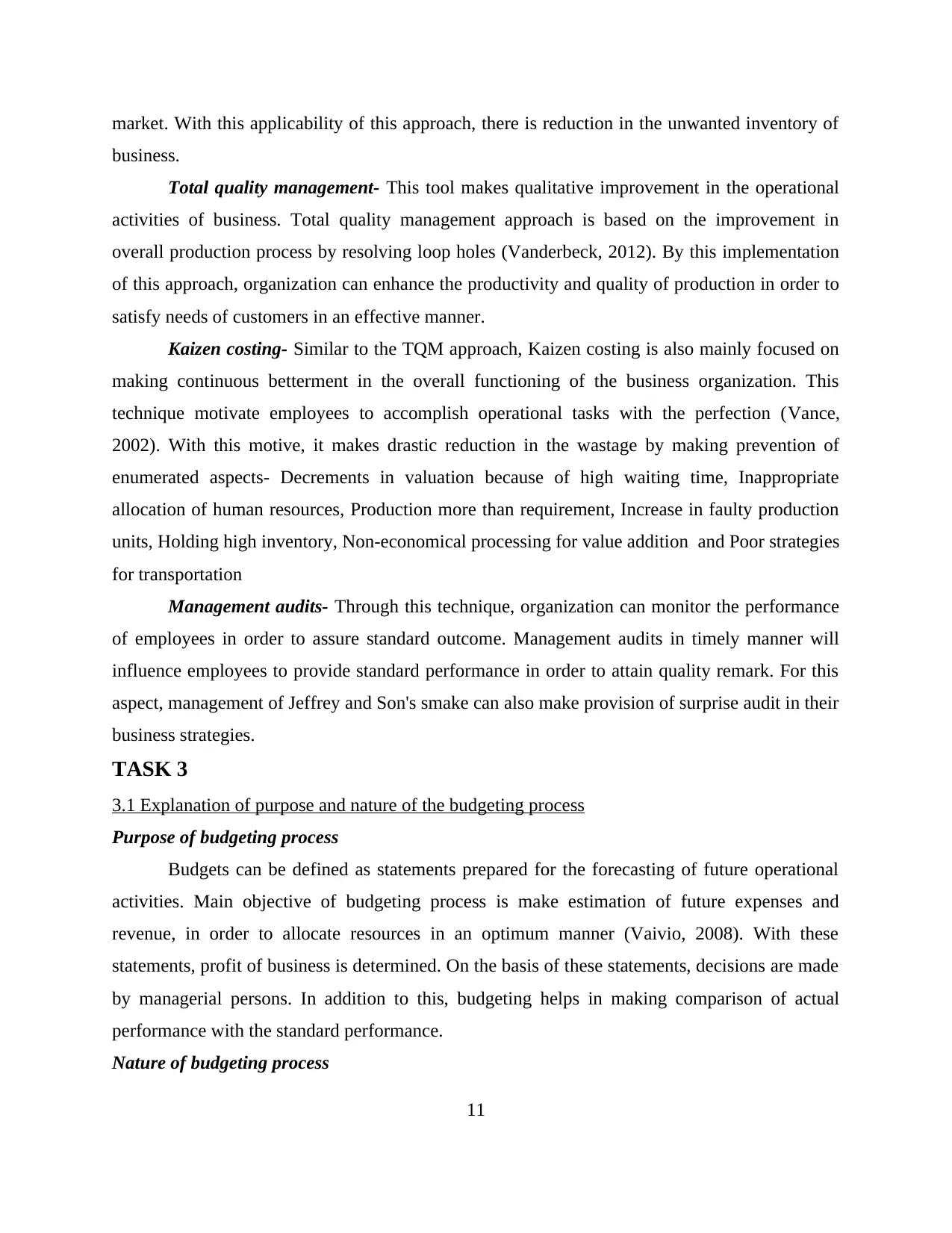
business.
Total quality management- This tool makes qualitative improvement in the operational
activities of business. Total quality management approach is based on the improvement in
overall production process by resolving loop holes (Vanderbeck, 2012). By this implementation
of this approach, organization can enhance the productivity and quality of production in order to
satisfy needs of customers in an effective manner.
Kaizen costing- Similar to the TQM approach, Kaizen costing is also mainly focused on
making continuous betterment in the overall functioning of the business organization. This
technique motivate employees to accomplish operational tasks with the perfection (Vance,
2002). With this motive, it makes drastic reduction in the wastage by making prevention of
enumerated aspects- Decrements in valuation because of high waiting time, Inappropriate
allocation of human resources, Production more than requirement, Increase in faulty production
units, Holding high inventory, Non-economical processing for value addition and Poor strategies
for transportation
Management audits- Through this technique, organization can monitor the performance
of employees in order to assure standard outcome. Management audits in timely manner will
influence employees to provide standard performance in order to attain quality remark. For this
aspect, management of Jeffrey and Son's smake can also make provision of surprise audit in their
business strategies.
TASK 3
3.1 Explanation of purpose and nature of the budgeting process
Purpose of budgeting process
Budgets can be defined as statements prepared for the forecasting of future operational
activities. Main objective of budgeting process is make estimation of future expenses and
revenue, in order to allocate resources in an optimum manner (Vaivio, 2008). With these
statements, profit of business is determined. On the basis of these statements, decisions are made
by managerial persons. In addition to this, budgeting helps in making comparison of actual
performance with the standard performance.
Nature of budgeting process
11
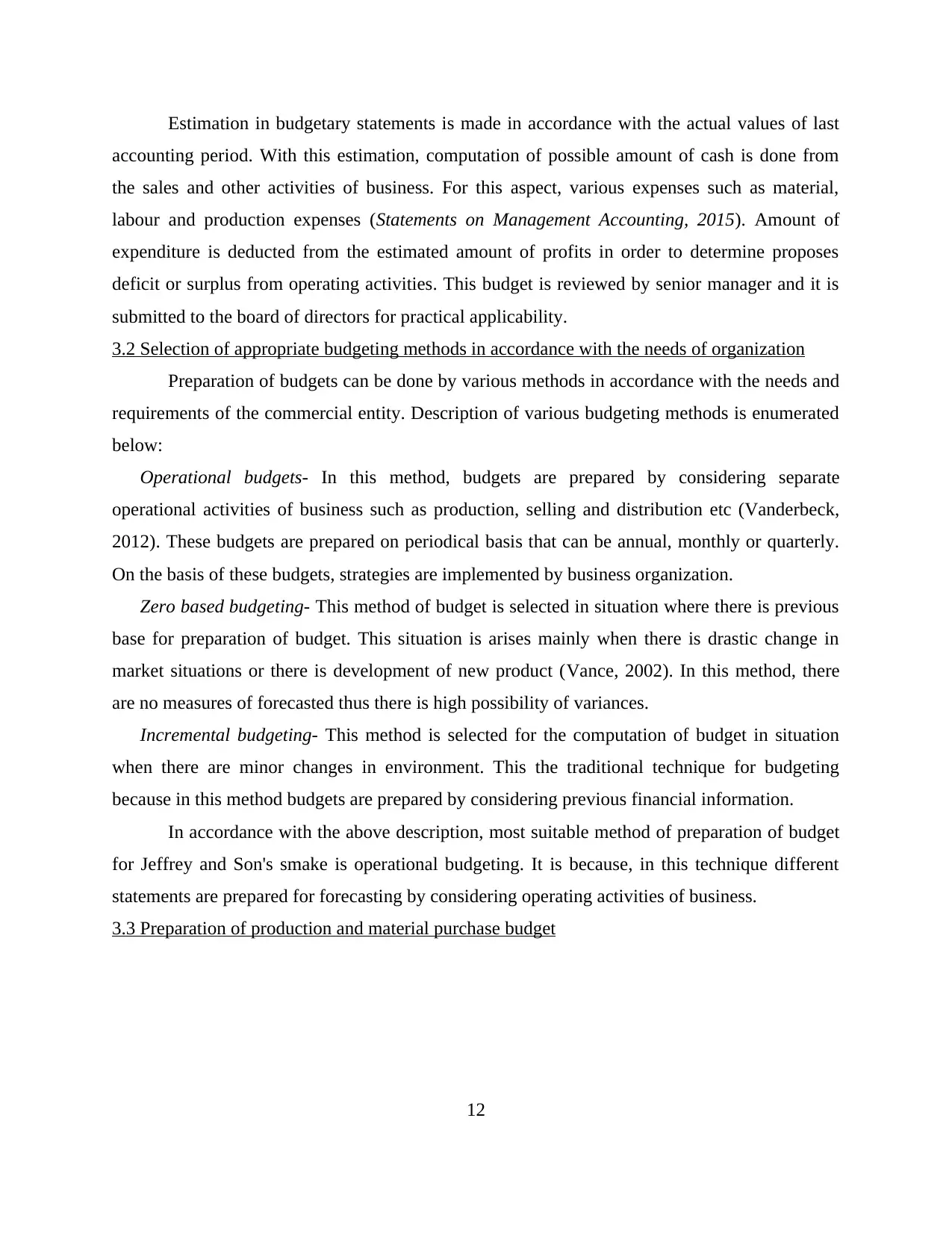
accounting period. With this estimation, computation of possible amount of cash is done from
the sales and other activities of business. For this aspect, various expenses such as material,
labour and production expenses (Statements on Management Accounting, 2015). Amount of
expenditure is deducted from the estimated amount of profits in order to determine proposes
deficit or surplus from operating activities. This budget is reviewed by senior manager and it is
submitted to the board of directors for practical applicability.
3.2 Selection of appropriate budgeting methods in accordance with the needs of organization
Preparation of budgets can be done by various methods in accordance with the needs and
requirements of the commercial entity. Description of various budgeting methods is enumerated
below:
Operational budgets- In this method, budgets are prepared by considering separate
operational activities of business such as production, selling and distribution etc (Vanderbeck,
2012). These budgets are prepared on periodical basis that can be annual, monthly or quarterly.
On the basis of these budgets, strategies are implemented by business organization.
Zero based budgeting- This method of budget is selected in situation where there is previous
base for preparation of budget. This situation is arises mainly when there is drastic change in
market situations or there is development of new product (Vance, 2002). In this method, there
are no measures of forecasted thus there is high possibility of variances.
Incremental budgeting- This method is selected for the computation of budget in situation
when there are minor changes in environment. This the traditional technique for budgeting
because in this method budgets are prepared by considering previous financial information.
In accordance with the above description, most suitable method of preparation of budget
for Jeffrey and Son's smake is operational budgeting. It is because, in this technique different
statements are prepared for forecasting by considering operating activities of business.
3.3 Preparation of production and material purchase budget
12
⊘ This is a preview!⊘
Do you want full access?
Subscribe today to unlock all pages.

Trusted by 1+ million students worldwide
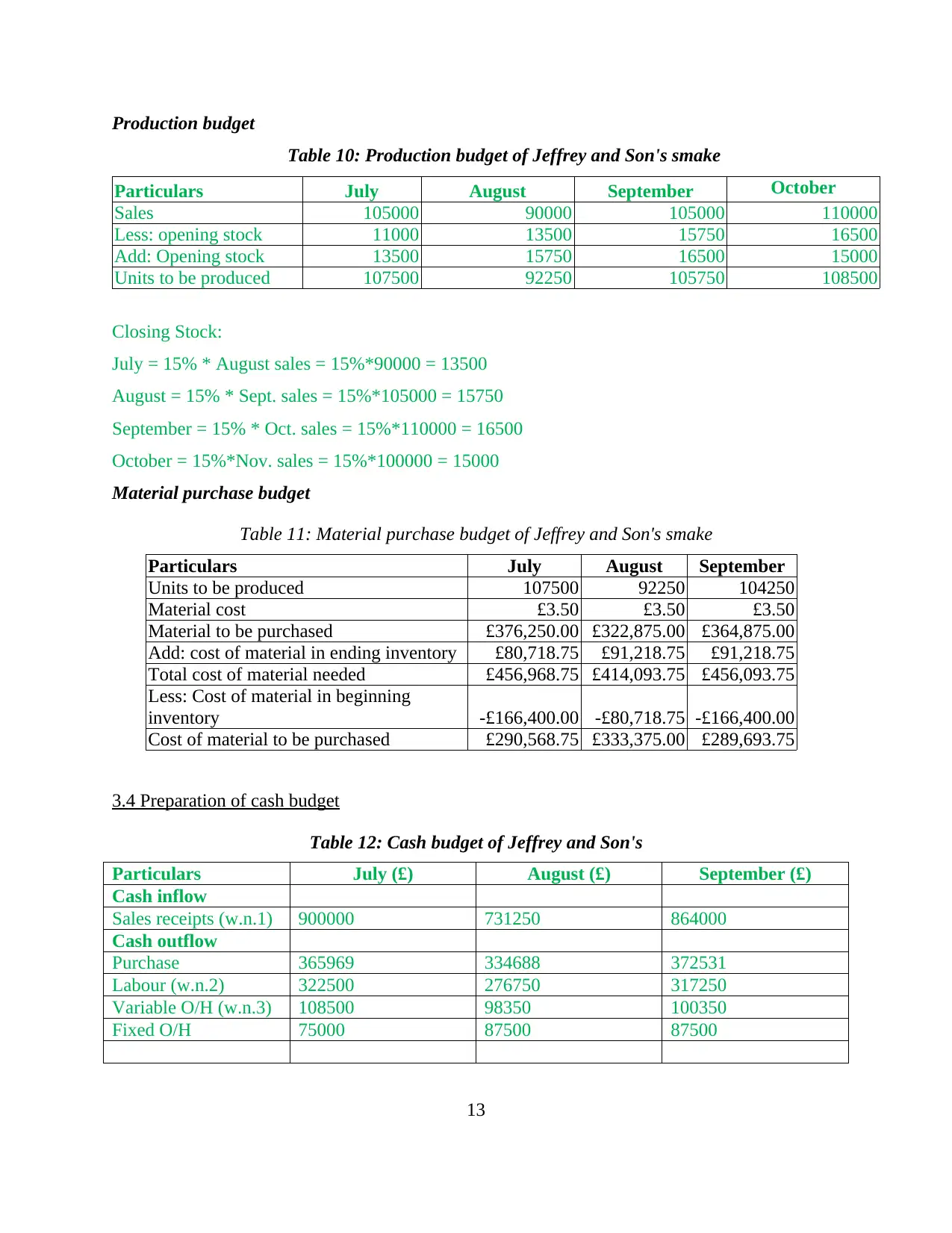
Table 10: Production budget of Jeffrey and Son's smake
Particulars July August September October
Sales 105000 90000 105000 110000
Less: opening stock 11000 13500 15750 16500
Add: Opening stock 13500 15750 16500 15000
Units to be produced 107500 92250 105750 108500
Closing Stock:
July = 15% * August sales = 15%*90000 = 13500
August = 15% * Sept. sales = 15%*105000 = 15750
September = 15% * Oct. sales = 15%*110000 = 16500
October = 15%*Nov. sales = 15%*100000 = 15000
Material purchase budget
Table 11: Material purchase budget of Jeffrey and Son's smake
Particulars July August September
Units to be produced 107500 92250 104250
Material cost £3.50 £3.50 £3.50
Material to be purchased £376,250.00 £322,875.00 £364,875.00
Add: cost of material in ending inventory £80,718.75 £91,218.75 £91,218.75
Total cost of material needed £456,968.75 £414,093.75 £456,093.75
Less: Cost of material in beginning
inventory -£166,400.00 -£80,718.75 -£166,400.00
Cost of material to be purchased £290,568.75 £333,375.00 £289,693.75
3.4 Preparation of cash budget
Table 12: Cash budget of Jeffrey and Son's
Particulars July (£) August (£) September (£)
Cash inflow
Sales receipts (w.n.1) 900000 731250 864000
Cash outflow
Purchase 365969 334688 372531
Labour (w.n.2) 322500 276750 317250
Variable O/H (w.n.3) 108500 98350 100350
Fixed O/H 75000 87500 87500
13
Paraphrase This Document
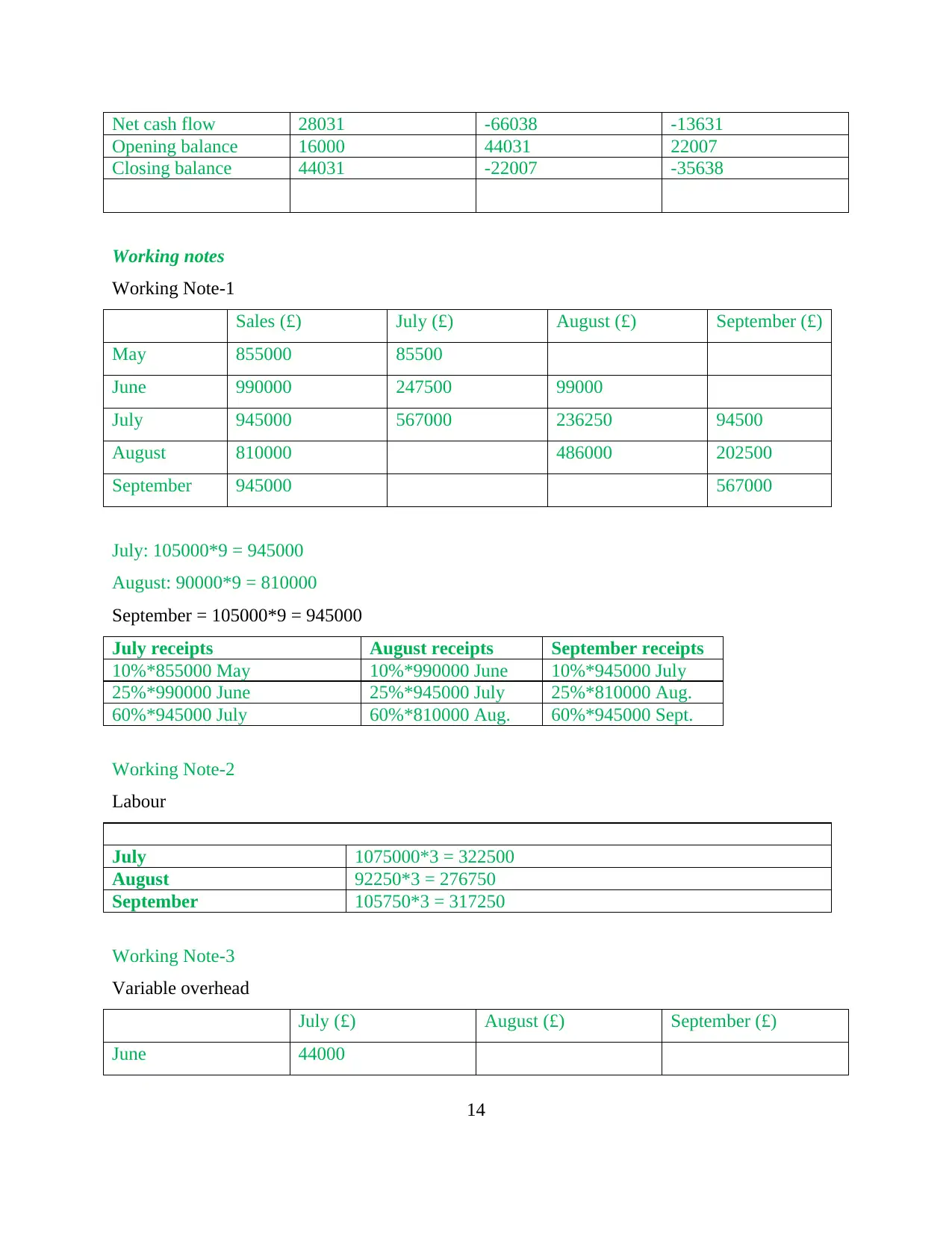
Opening balance 16000 44031 22007
Closing balance 44031 -22007 -35638
Working notes
Working Note-1
Sales (£) July (£) August (£) September (£)
May 855000 85500
June 990000 247500 99000
July 945000 567000 236250 94500
August 810000 486000 202500
September 945000 567000
July: 105000*9 = 945000
August: 90000*9 = 810000
September = 105000*9 = 945000
July receipts August receipts September receipts
10%*855000 May 10%*990000 June 10%*945000 July
25%*990000 June 25%*945000 July 25%*810000 Aug.
60%*945000 July 60%*810000 Aug. 60%*945000 Sept.
Working Note-2
Labour
July 1075000*3 = 322500
August 92250*3 = 276750
September 105750*3 = 317250
Working Note-3
Variable overhead
July (£) August (£) September (£)
June 44000
14
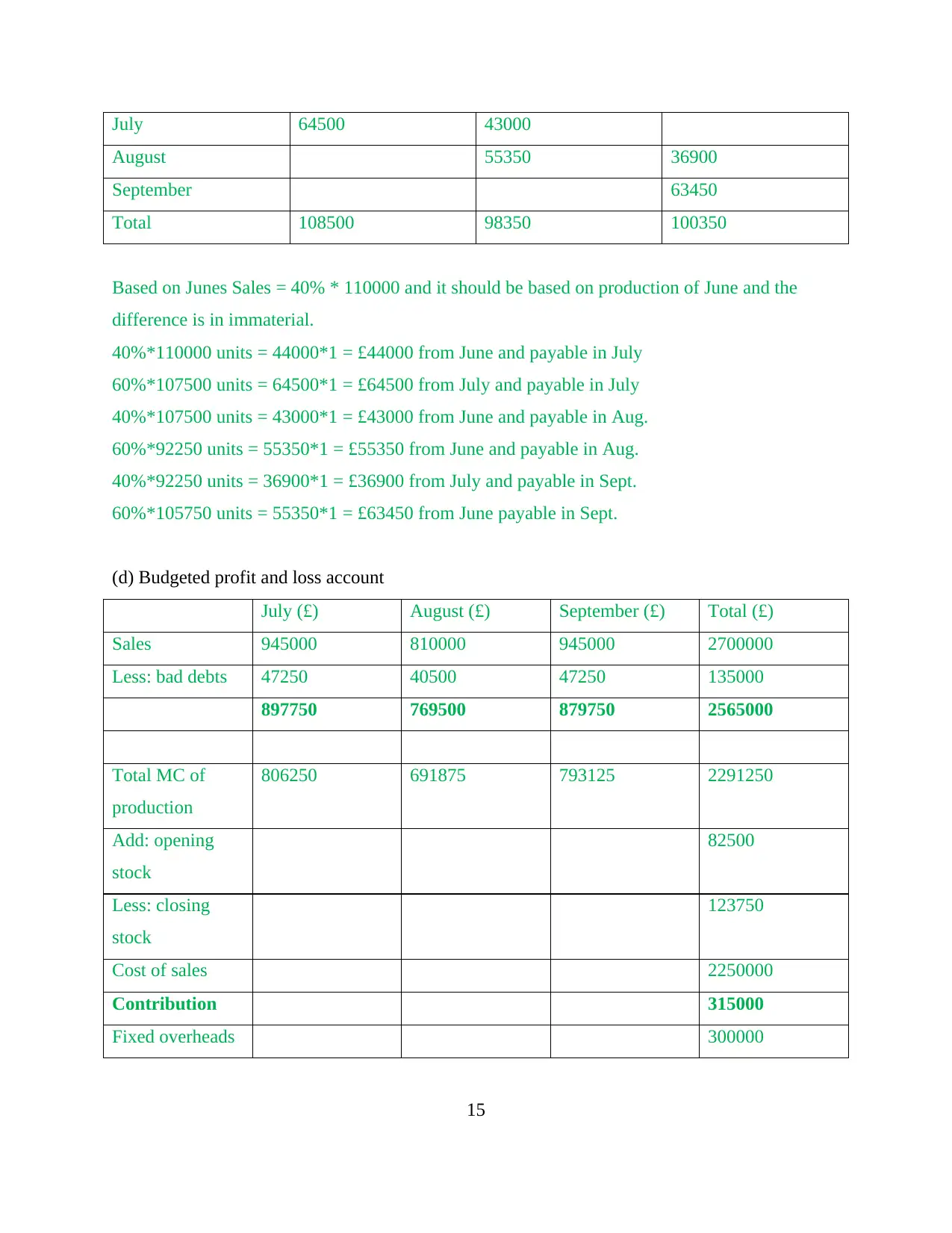
August 55350 36900
September 63450
Total 108500 98350 100350
Based on Junes Sales = 40% * 110000 and it should be based on production of June and the
difference is in immaterial.
40%*110000 units = 44000*1 = £44000 from June and payable in July
60%*107500 units = 64500*1 = £64500 from July and payable in July
40%*107500 units = 43000*1 = £43000 from June and payable in Aug.
60%*92250 units = 55350*1 = £55350 from June and payable in Aug.
40%*92250 units = 36900*1 = £36900 from July and payable in Sept.
60%*105750 units = 55350*1 = £63450 from June payable in Sept.
(d) Budgeted profit and loss account
July (£) August (£) September (£) Total (£)
Sales 945000 810000 945000 2700000
Less: bad debts 47250 40500 47250 135000
897750 769500 879750 2565000
Total MC of
production
806250 691875 793125 2291250
Add: opening
stock
82500
Less: closing
stock
123750
Cost of sales 2250000
Contribution 315000
Fixed overheads 300000
15
⊘ This is a preview!⊘
Do you want full access?
Subscribe today to unlock all pages.

Trusted by 1+ million students worldwide
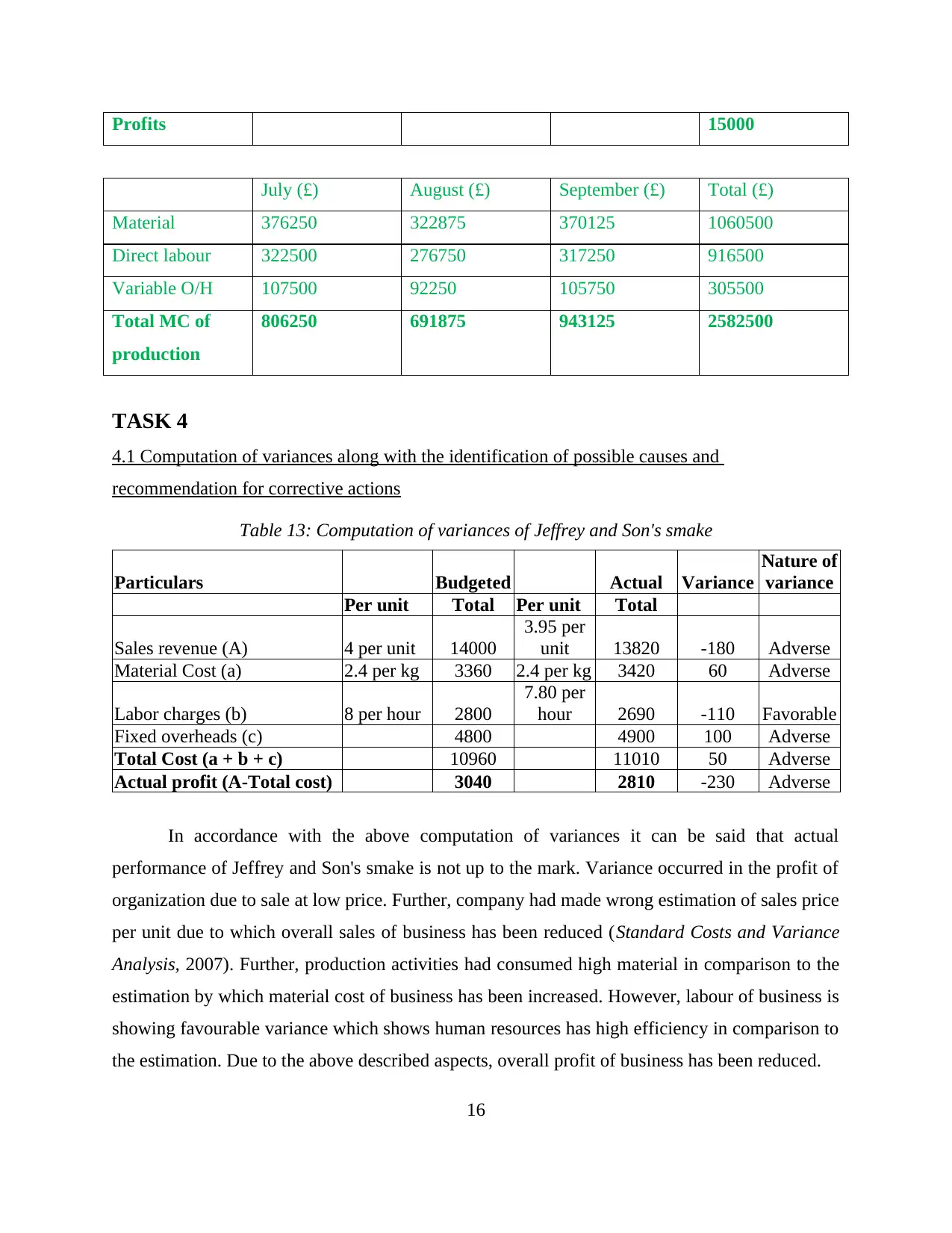
July (£) August (£) September (£) Total (£)
Material 376250 322875 370125 1060500
Direct labour 322500 276750 317250 916500
Variable O/H 107500 92250 105750 305500
Total MC of
production
806250 691875 943125 2582500
TASK 4
4.1 Computation of variances along with the identification of possible causes and
recommendation for corrective actions
Table 13: Computation of variances of Jeffrey and Son's smake
Particulars Budgeted Actual Variance
Nature of
variance
Per unit Total Per unit Total
Sales revenue (A) 4 per unit 14000
3.95 per
unit 13820 -180 Adverse
Material Cost (a) 2.4 per kg 3360 2.4 per kg 3420 60 Adverse
Labor charges (b) 8 per hour 2800
7.80 per
hour 2690 -110 Favorable
Fixed overheads (c) 4800 4900 100 Adverse
Total Cost (a + b + c) 10960 11010 50 Adverse
Actual profit (A-Total cost) 3040 2810 -230 Adverse
In accordance with the above computation of variances it can be said that actual
performance of Jeffrey and Son's smake is not up to the mark. Variance occurred in the profit of
organization due to sale at low price. Further, company had made wrong estimation of sales price
per unit due to which overall sales of business has been reduced (Standard Costs and Variance
Analysis, 2007). Further, production activities had consumed high material in comparison to the
estimation by which material cost of business has been increased. However, labour of business is
showing favourable variance which shows human resources has high efficiency in comparison to
the estimation. Due to the above described aspects, overall profit of business has been reduced.
16
Paraphrase This Document
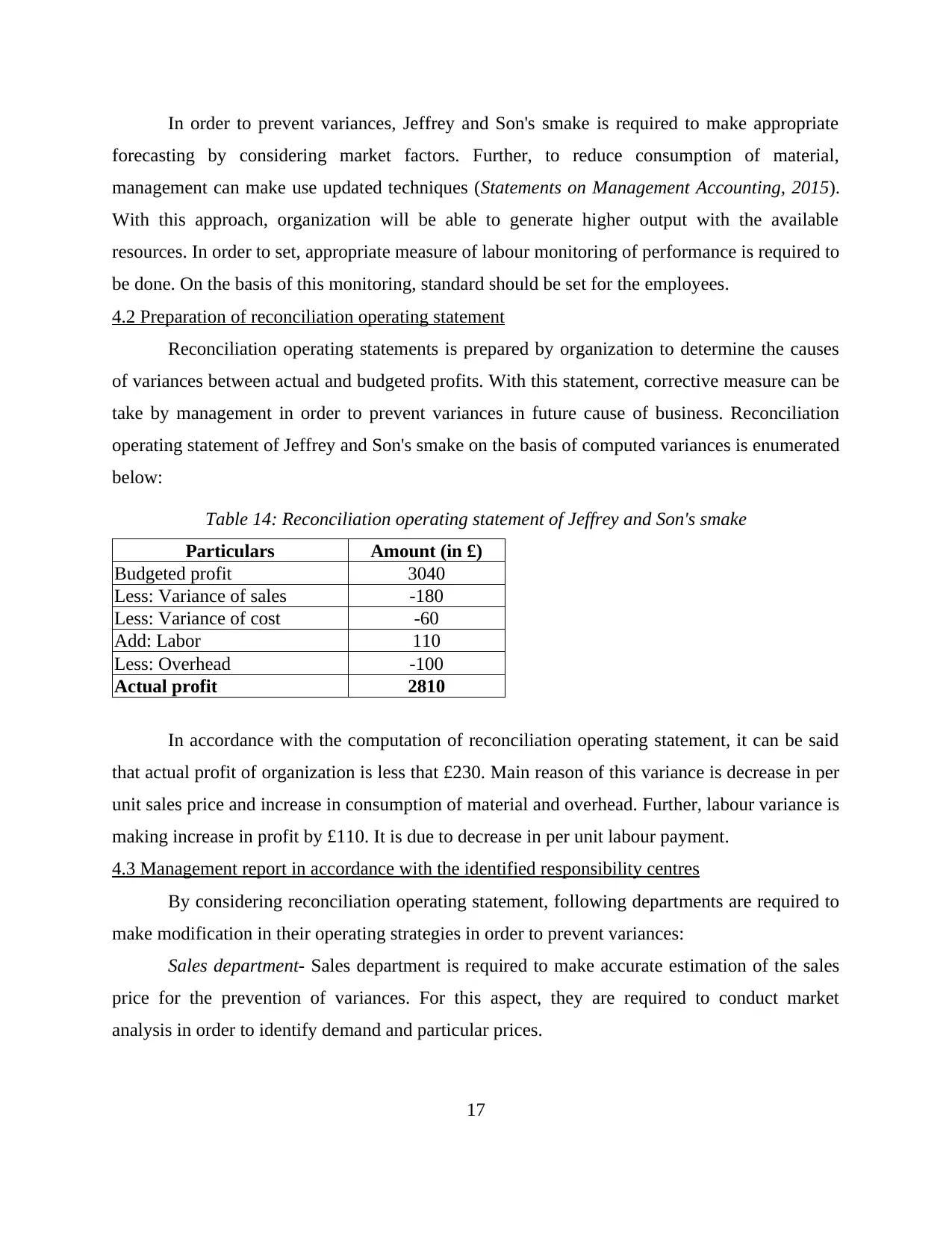
forecasting by considering market factors. Further, to reduce consumption of material,
management can make use updated techniques (Statements on Management Accounting, 2015).
With this approach, organization will be able to generate higher output with the available
resources. In order to set, appropriate measure of labour monitoring of performance is required to
be done. On the basis of this monitoring, standard should be set for the employees.
4.2 Preparation of reconciliation operating statement
Reconciliation operating statements is prepared by organization to determine the causes
of variances between actual and budgeted profits. With this statement, corrective measure can be
take by management in order to prevent variances in future cause of business. Reconciliation
operating statement of Jeffrey and Son's smake on the basis of computed variances is enumerated
below:
Table 14: Reconciliation operating statement of Jeffrey and Son's smake
Particulars Amount (in £)
Budgeted profit 3040
Less: Variance of sales -180
Less: Variance of cost -60
Add: Labor 110
Less: Overhead -100
Actual profit 2810
In accordance with the computation of reconciliation operating statement, it can be said
that actual profit of organization is less that £230. Main reason of this variance is decrease in per
unit sales price and increase in consumption of material and overhead. Further, labour variance is
making increase in profit by £110. It is due to decrease in per unit labour payment.
4.3 Management report in accordance with the identified responsibility centres
By considering reconciliation operating statement, following departments are required to
make modification in their operating strategies in order to prevent variances:
Sales department- Sales department is required to make accurate estimation of the sales
price for the prevention of variances. For this aspect, they are required to conduct market
analysis in order to identify demand and particular prices.
17
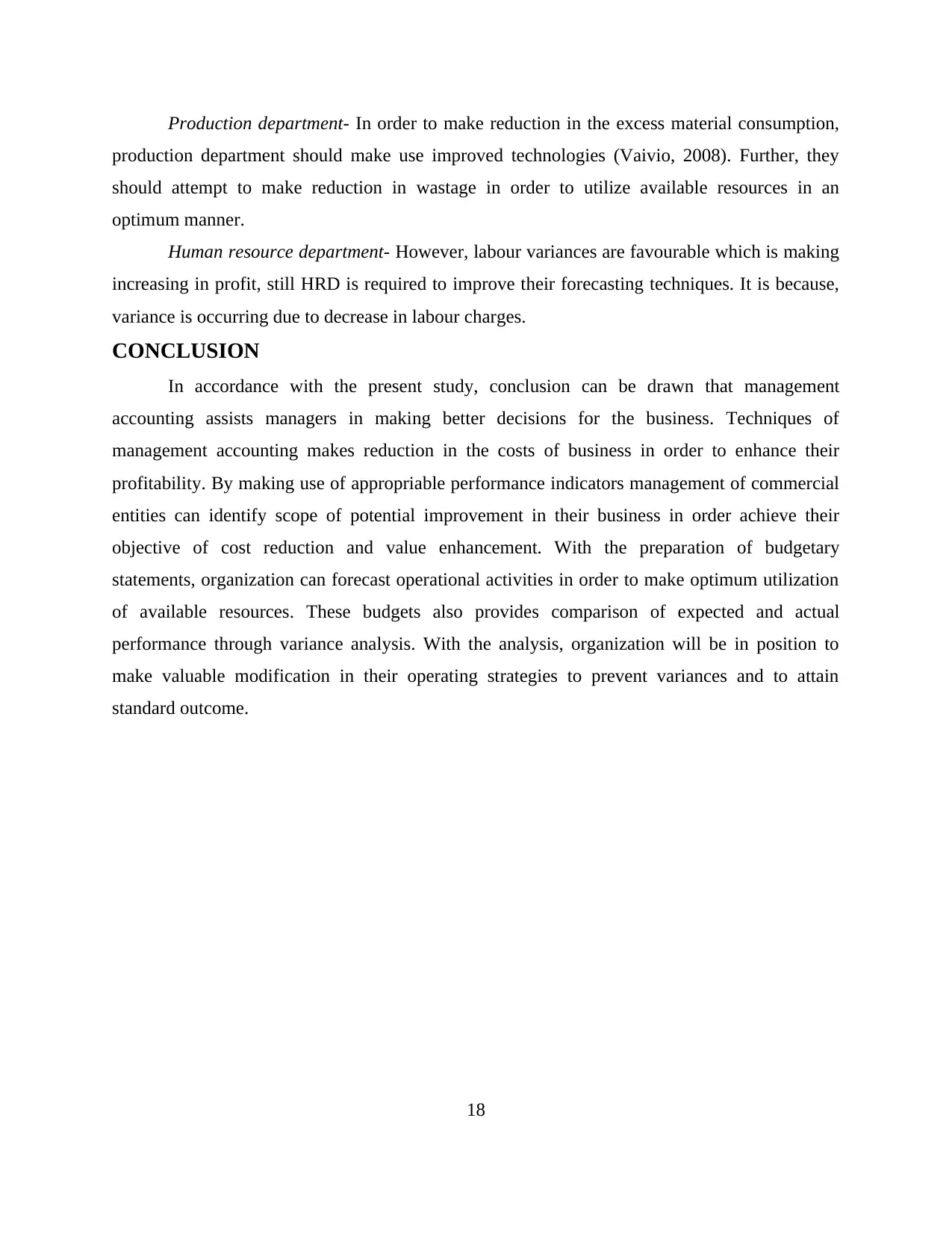
production department should make use improved technologies (Vaivio, 2008). Further, they
should attempt to make reduction in wastage in order to utilize available resources in an
optimum manner.
Human resource department- However, labour variances are favourable which is making
increasing in profit, still HRD is required to improve their forecasting techniques. It is because,
variance is occurring due to decrease in labour charges.
CONCLUSION
In accordance with the present study, conclusion can be drawn that management
accounting assists managers in making better decisions for the business. Techniques of
management accounting makes reduction in the costs of business in order to enhance their
profitability. By making use of appropriable performance indicators management of commercial
entities can identify scope of potential improvement in their business in order achieve their
objective of cost reduction and value enhancement. With the preparation of budgetary
statements, organization can forecast operational activities in order to make optimum utilization
of available resources. These budgets also provides comparison of expected and actual
performance through variance analysis. With the analysis, organization will be in position to
make valuable modification in their operating strategies to prevent variances and to attain
standard outcome.
18
⊘ This is a preview!⊘
Do you want full access?
Subscribe today to unlock all pages.

Trusted by 1+ million students worldwide

Books and journals
Banks, A., 2008. Budgeting. 3rd ed. McGraw-Hill Australia.
Bhimani, A., and Bromwich, M., 2009. Management Accounting: Retrospect and prospect.
Elsevier.
Burns, J., Hopper, T. and Yazdifar, H., 2004. Management accounting education and training:
putting management in and taking accounting out. Qualitative Research in Accounting &
Management. 1(1). pp.1 – 29.
Chapman, S. C, 2008. We are not alone: qualitative management accounting research: Rationale,
pitfalls and potential. Qualitative Research in Accounting & Management, 5 (3). pp.247
- 252
Jiambalvo, J., 2001. Managerial accounting. Wiley.
Keown, A., 2005. Financial management. Upper Saddle River, N.J.: Pearson/Prentice Hall.
Kont, R. K., 2013. Cost accounting and scientific management in libraries: a historical overview.
Journal of Management History. 19(2). pp.225 – 240.
Lucey, T., 2002. Costing. Continuum.
Obura, O. C. and Bukenya, K. N. M. I., 2008. Financial management and budgeting strategies
for LIS programmes: Uganda's experience. Library Review.57(7). pp.514 – 527.
Prior, P. B., 2004. Managing Financial Resources and Decisions. BPP Professional Education.
Vaivio, J., 2008. Qualitative management accounting research: rationale, pitfalls and potential.
Qualitative Research in Accounting & Management. 5(1). pp.64 – 86.
Vance, D., 2002. Financial Analysis and Decision Making. McGraw Hill Professional.
Vanderbeck, J. E., 2012. Principles of Cost Accounting. 16th ed. Cengage Learning.
Zawawi, M. H. N., and Hoque, Z., 2010. Research in management accounting innovations: An
overview of its recent development. Qualitative Research in Accounting & Management.
7(4). pp.505 – 568.
Online
Key Performance Indicators. 2014. [Online]. Available at:
<http://blog.claytonmckervey.com/blog/2011/01/24/key-performance-indicators/>
[Accessed on 3rd December 2015].
19
Paraphrase This Document
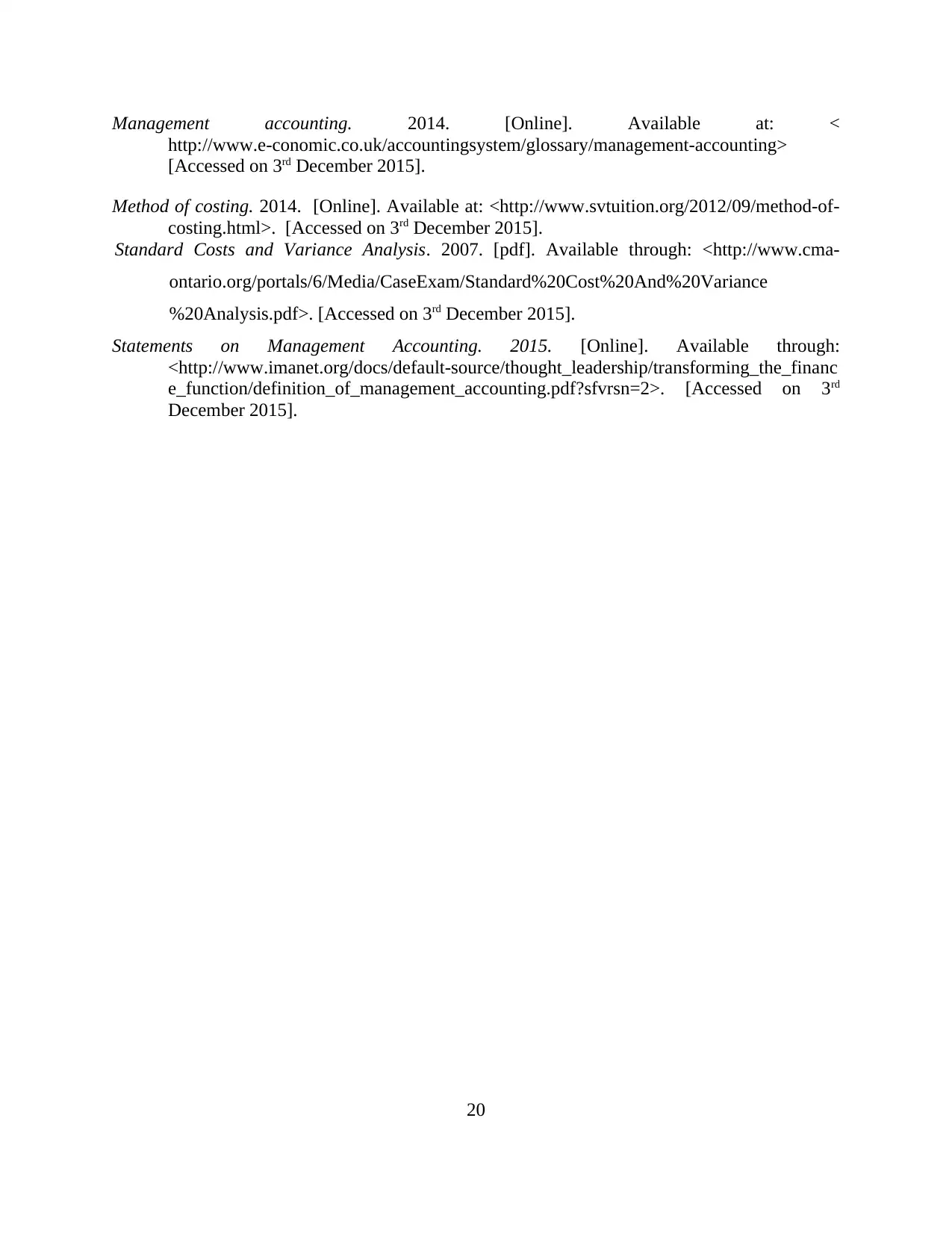
http://www.e-conomic.co.uk/accountingsystem/glossary/management-accounting>
[Accessed on 3rd December 2015].
Method of costing. 2014. [Online]. Available at: <http://www.svtuition.org/2012/09/method-of-
costing.html>. [Accessed on 3rd December 2015].
Standard Costs and Variance Analysis. 2007. [pdf]. Available through: <http://www.cma-
ontario.org/portals/6/Media/CaseExam/Standard%20Cost%20And%20Variance
%20Analysis.pdf>. [Accessed on 3rd December 2015].
Statements on Management Accounting. 2015. [Online]. Available through:
<http://www.imanet.org/docs/default-source/thought_leadership/transforming_the_financ
e_function/definition_of_management_accounting.pdf?sfvrsn=2>. [Accessed on 3rd
December 2015].
20
Related Documents
Your All-in-One AI-Powered Toolkit for Academic Success.
+13062052269
info@desklib.com
Available 24*7 on WhatsApp / Email
![[object Object]](/_next/static/media/star-bottom.7253800d.svg)
© 2024 | Zucol Services PVT LTD | All rights reserved.





